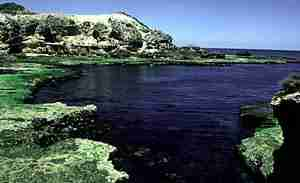|
|

Algae
What is Seaweed ?

Most of the plants that live on the intertidal rocky shore, or under the water along our seashores, are algae. Most people call these algae plants seaweed, or kelp.
There are a few underwater-living flowering plants, called seagrasses. They usually live in saltwater estuaries. Some also live along our ocean shores. Like land plants, these flowering plants have a root system to take up nutrients. They absorb sunlight through their leaves and have small flowers for reproduction. Algae are quite different.
Algae
Algae have quite a number of features which make them unlike normal land-based flowering plants.
Firstly, they do not have a root system which takes up nutrients. Algae take their food in through their leaf-like fronds which are surrounded by nutrient-carrying seawater. Their "roots" are are called holdfasts, and that is what they do. They hold the algae down firmly onto the rock surface.
Algae also reproduce quite differently to the flowering plants. They have spores like the ferns, mosses, lichens and liverworts.
Algae are divided into three main groups. There are green, brown and red algae, which differ in having different photosynthetic pigment systems.
Green Algae - Phylum Chlorophyta
Green algae get their colour from the photosynthetic chlorophyll pigments. They come in a variety of shapes including flat sheets, cylinders, strings of beads, spheres, or hair-like filaments.
Green algae are common in the intertidal zones and in shallow water as well as in some freshwater habitats, where light is plentiful.
Some examples of Green Algae are:
![]() Sea
Lettuce, Ulva spp.
Sea
Lettuce, Ulva spp.
![]() Green
Sea Velvet, Codium fragile
Green
Sea Velvet, Codium fragile
![]() Caulerpa,
Caulerpa filiformis
Caulerpa,
Caulerpa filiformis
Brown Algae - Phylum Phaeophyta
Brown algae have additional pigments which mask the green chlorophyll. These pigments allow the brown algae to extend their range down into deeper waters because the pigments are more efficient than green chlorophyll in absorbing the sunlight down away from the ocean surface.
Brown algae also come in a wide variety of forms. Some brown algae are the largest, longest and most conspicuous seaweeds found on rocky ocean shores. They are a common feature of the low-shore fringe and shallow sub-tidal zones. Some brown algae from southern Australian seas are the fastest growing of all plants.
Some examples of Brown Algae are:
![]() Neptune's
Necklace, Hormosira banksii
Neptune's
Necklace, Hormosira banksii
![]() Globe
Algae, Colpomenia sinuosa
Globe
Algae, Colpomenia sinuosa
![]() Leather
Kelp, Eklonia radiata
Leather
Kelp, Eklonia radiata
![]() Strap
Weed, Phyllospora comosa
Strap
Weed, Phyllospora comosa
Red Algae - Phylum Rhodophyta
Red algae come in a variety of shades of red due to additional red protein pigments in the fronds. The red colour is not uniform and some species are purple, mauve, orange or even yellow.
These pigments allow the red algae to grow at far greater depths than the green and brown algae. Red algae can occur down to 200 metres.
Red algae have a wide variety of forms, including encrusting, string-like, tube-like, filamentous and flat sheets. Red algae rarely are important in rocky shore or reef communities. They prefer deeper waters.
Some examples of Red Algae are:
![]() Coralline
seaweed, Corallina officinalis
Coralline
seaweed, Corallina officinalis
![]() Encrusting
Corallines, Coralline Algae
Encrusting
Corallines, Coralline Algae
Macroalgae and Microalgae
The large algae, or macroalgae, are the largest and most obvious forms of algae that we can easily see.
However, there are the microalgae, and just hatched spores of all algae, that coat the floor of many rockshore pools and surfaces. This forms one of the most important food sources for algae-eating molluscs. We call these algae-eating animals herbivores.
Much microalgae also drifts around in the ocean currents as part of the plankton. This is a major source of food for many oceanic and seashore animals and their juvenile planktonic stages.
References
Bennett, I. (1987) W.J. Dakin's classic study: Australian Seashores. Angus & Robertson, Sydney.
Davey, K. (1998) A Photographic Guide to Seashore Life of Australia. New Holland, Sydney.
Edgar, G. J. (1997) Australian Marine Life: the plants and animals of temperate waters. Reed Books, Kew.
Quinn, G. P., Wescott, G. C. & Synnot, R. N. (1992) Life on the Rocky Shores of South-Eastern Australia: an illustrated field guide. Victorian National Parks Association, Melbourne.
Underwood, A. J. & Chapman, M. G. (1993) Seashores: a beachcomber's guide. New South Wales University Press, Sydney.
Womersley, H. B. S. (1987) The Marine Benthic Flora of Southern Australia. pt.1 , South Australian Government Printer, Adelaide.
Home
Page
Taxonomy
Biogeography
Rocky Shores
Tidal Levels
Intertidal Zonation
Environmental Factors
Biological
Factors
Feeding Relationships
Activities
Glossary
References
 Life
on Australian Seashores
Life
on Australian Seashores
by Keith Davey (C) 2000
Learning Consultant
- Media
The University of Newcastle
email at australian_seashores@hotmail.com
Scientific Consultant: Phil
Colman
site created 01.01.98 : updated 01.04.2000